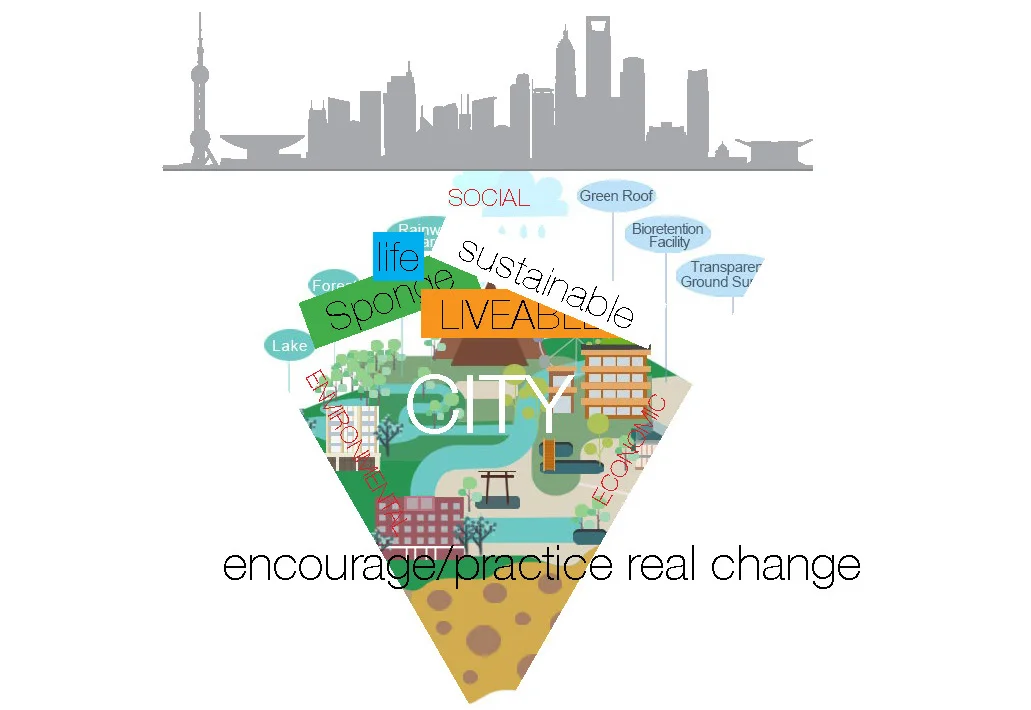COMPOSITIONAL PRINCIPLES FOR ECOLOGICAL DESIGN: SPONGE CITIES
For iPD, design involves not just taking into account the project variables and parameters, but looking to the future. Innovative water sensitive urban design (WSUD) has the capacity to fundamentally transform approaches to landscape, as well as the interaction between the practice of design and the concept of sustainability. As such, WSUD is an integral part of iPD’s future oriented design.
A ‘sponge city’ is China’s counterpart to the Australian acronym, ‘WSUD.’ In September 2015, 16 Chinese cities became ‘sponge cities’: urban areas that will be transformed by water sensitive design. ‘Sponge cities’ incorporate urban design that aims to reduce the risk of floods, by enabling cities to ‘absorb’ water. This responds to the challenges of urban high density as well as to the potential for more frequent extreme weather events with the onset of climate change. The great concrete edifice of the city only does one thing with the water that arrives on its streets: redirect it to drains and then out into the sea as stormwater. For cities that will experience more frequent flooding in future years, this won’t adequately redirect all the water, prompting flooding and damage. For cities whose sources of water will become unreliable in future years, like Los Angeles, the rain that is redirected to stormwater drains could become a vital resource. Rather than being lost as stormwater run off, rain can be captured by ‘sponge’ design and technology and can be reused, for plant irrigation, households and cooling.
Whilst the principles of WSUD are well known, the application of these principles in park and residential development lags far behind. One of the reasons for this lag is the weak integration of sustainable or ‘sensitive’ principles with design. Many stakeholders and design professionals see WSUD or sponge technology and principles as a separate feature of a project, which can be attached to a site as a module. Contrary to this attitude, iPD takes a metic approach to sustainable design. Rather than seeing water sensitivity as an optional element of the design, iPD use water sensitivity as the tactical or strategic attitude that undergirds the entire approach to the project, providing the foundation for creativity rather than just one parameter. WSUD is not a virtuous afterthought for contemporary design, but needs to be the designer’s navigational tool in their approach to the site. iPD’s New Life Hub Mix-used project is a good example of this type of design. The architects had incorporated a big, sloping lawn in front of the buildings, and iPD used this slope to integrate several different elements of WSUD, using plants and the gradient that provides accessibility to the site to carry out water filtration. At first glance the landscaping does not look like an ecological feature, because every ecological element is at once an element of composition. Here lies the difference in iPD’s approach: the ecological is always, already, a key compositional principle. The ecological and the aesthetic, here, are co-implicated; one does not supplement the other. This sort of metic design is the urban modality for the Anthropocene: adaptive, predictive, pragmatic and fundamentally creative, turning aesthetic opportunities into new ways of relating to natural resources.
Filtration, key to WSUD, is a process that is not entirely different from composition. It involves a temporal progression, spatial order and careful material interaction. You start with a rubbish trap, to filter debris from water, and then you allow the water to move through different layers of sand, which are composed as a rain garden. What follows the rain garden is a treatment wetland, where the water moves through different ponds, each of which are a different depth, and contain different plants. These wetland plants trap different pollutants, depending on their depth. Following this, the water is allowed to cascade, reoxygenising it. By the end of this process the water quality is significantly improved. Filtration thus offers a particularly subtle interaction between the orchestrated and the organic, between design and mechanism. This interplay of opposites, and the integration of design and sustainability, allow for both aesthetic innovation and future oriented design.
